| |
|
|
| ■ |
|
A sculpted head |
|
|
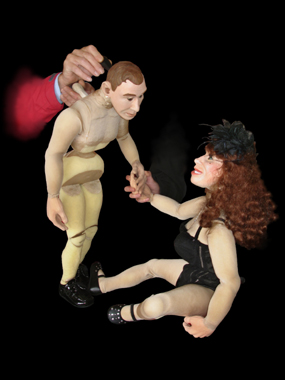 |
This section is intended for people keen on building details. It reveals bits of the many techniques that I combine for the creation of the “Âmes imaginaires” (litterally imaginary souls).
These techniques are the fruits of my patient self-taught collection approach (See also the roots of the “Âmes imaginaires”), as well as the discoveries of those before me who took pleasure on this path. |
|
The building stages
In general, apart from special orders (for which I extend detailed specifications), every creation is inspired by a certain facial expression which evokes a personal feeling in me, wether it be the result of an actual meeting, a photograph or a caricature. The birth of a new “soul” therefore always arises from a face.
|
■ A sculpted head |
Indeed, the building itself always starts with the head. From a selection of pictures taken from magazines, I choose the facial expression that will be my starting point for the modelling of the contours of the face. Then, as the modelling continues, I let new expressions reveal themselves (as, except for sculpture made to ressemble a specific person, I do not seek an accurate copy).
In fact, every new head is inspired by a mix of several emotions. The ambiguous expression that results from this mix produces the impression of true presence in the character.
The choice of material depends on the type of creation : |
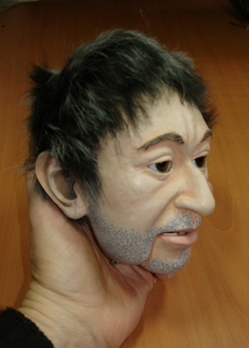 |
- For a light weight and unbreakable mobile creation, the best suitted material is the wood paste (a mix of cellulose, water and glue). As it dehydrates, this very pliable material gets light and extremely hard. The challenge this presents is that during air-drying, the volume reduces and changes the contours of modelled face. To meet this challenge and reduce air-drying time, I use a styrofoam ball as the base for wood paste. I commonly proceed by modelling moderated contours in 3 successive layers.
- For immobile creations of figures, art dolls and and dressed bust type, the contraints of weight and durability are reduced. In some cases, it is possible to use ready to use air drying pastes (such as the brands “La Doll”, “Premier”, “Darwi”...). They allow very accurate modelling, do not lose their shape when drying and can withstand sanding.
|
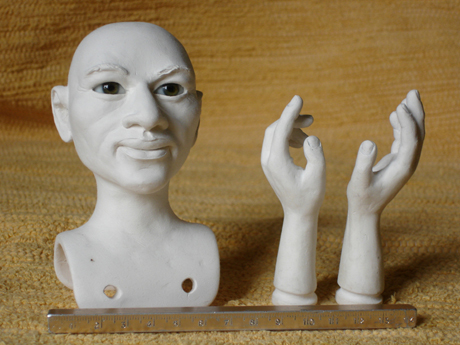 |
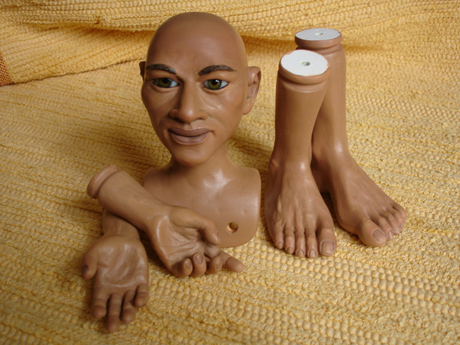 |
|
The decision to insert glass eyes has to be made at the very beginning of modelling. At that time, the eyes can be set into the paste. The carefully sculpted overlap areas will become the eyelids.
After drying, the head is delicately sanded. Then, I apply what I call my “foundation cream”. It is a thick layer of acrylic vinyl paint (referred to as “Flash” brand by “Lefranc & Bourgeois”) which is dull, opaque and heavily pigmented. When drying this paint layer gets finner and litterally encapsulates the sculpted head. The selected skin colour for the base layer must be the darkest, as it will be seen into the face hollows.
It is actually the brushwork in a gradation of lighter and lighter skin colours on the embossed areas (cheeks, nostrils, chin, brow, eyelids, ear lobes...) that accentuates the contours and reveals the character. The expression is emphasized by the painting of eye outline, lips and eyebrows.
For short or medium long hair, I usually proceed by affixing pieces of natural fur (using neoprene glue). |
|
For a long hair effect, I create my own wig. I proceed by sewing a woven cord of natural or synthetic hair (found at “Afro” hairdresser suppliers) on an extendable knitted material. This extendable wig is then directly glued on the head (using neoprene glue).
■ Hands, feet and shoes :
Always in proportion with head dimensions, for these none-moulded parts, upmost precision is necessary to build consistent pairs. In mobile jointed creations, these are also the weakest parts. Consequently, they have to be strenghened by inserting iron wires at the very beginning of modelling, at a stage when finger volume exists only in the imagination.
|
|
Each “iron wire finger” is then wrapped with adhesive paper that will provide a base for the paste used for the modelling of finger flesh.
|
|
Following the same building procedure (iron framework, adhesive paper base and hardened wood paste surface), it is possible to create infinitely diverse shoe shapes. Joining the shoe to the character’s leg can be easily achieved thanks to iron wire loops prepared at sole level at the very first building step. This hidden joint will act as a true ankle, allowing slight swinging movements.
■ A body :
Whether for a realistic or caricatured character, only the proportions change. To determine dimensions, the reference remains the head. The building techniques themselves are numerous : an iron framed body for a fixed position creation , an assembly of hollow parts or compact sections of wood and sculpted foam for a jointed body...
|
|
The characteristics of the desired movement are the drivers for the selection of the most appropriate building technique. Indeed, locked or pliable joints are available in a great variety of configurations. In this field, a string puppet for performance – a magical object designed for pre-determined movements - is an extremely formative building exercise. Each finished puppet is the result of an in-depth technical analysis.
|
|
For me, the dressing of the body remains a key element that personifies the character. Differences in morphology require making patterns specific to each creation. The costume’s sophistication must not hinder the character’s motion. Indeed, this complementary part of the process has to meet classic requirements of the costume designer.
|
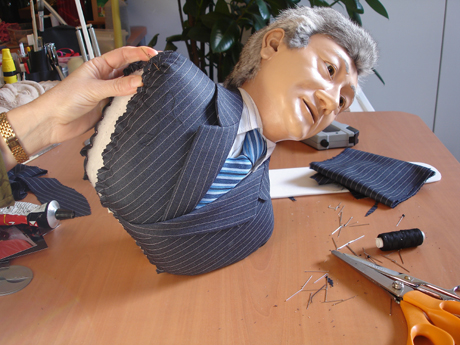 |
The manipulation of textures and materials creates the illusion of the true-life existence of these materializations of the imaginary : natural fur, leather, fabrics, perls... Details borrowed from the realm of harmony or anachronism strike us and invite us to invent stories for them. |
|
For those interested in further treatment of the subject and/or in starting for their own creations, I recommend the careful reading of the following books dedicated to the professional puppetry world. There, ingenious treasures are within arm’s reach. Assiduous practice will do the rest.
In exhibitions and other events where the “Âmes imaginaires” are involved, I propose some live demonstration sessions to illustrate some highlights in the building stages of a new “Âme” (soul).
For puppet fans, I propose workshops (see the news and for not missing any piece of information connect on http://facebook.com/ames.imaginaires ).
|

|
|
|
| ■ |
|
Hands, feet and shoes |
| ■ |
|
A body |
| |
|

